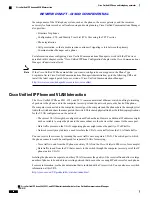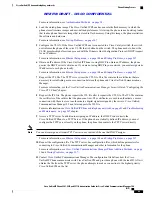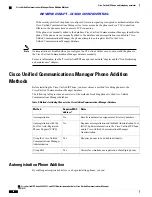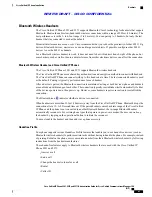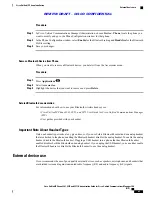
•
Add phones without first gathering MAC addresses from the phones.
•
Automatically add a Cisco Unified IP Phone to the Cisco Unified Communications Manager database
when you physically connect the phone to your IP telephony network. During autoregistration,
Cisco Unified Communications Manager assigns the next available sequential directory number to the
phone.
•
Quickly enter phones into the Cisco Unified Communications Manager database and modify any settings,
such as the directory numbers, from Cisco Unified Communications Manager.
•
Move autoregistered phones to new locations and assign them to different device pools without affecting
their directory numbers.
Cisco recommends that you use autoregistration to add fewer than 100 phones to your
network. To add more than 100 phones to your network, use the Bulk Administration
Tool (BAT).
Note
Autoregistration is disabled by default. In some cases, you might not want to use autoregistration; for
example, if you want to assign a specific directory number to the phone, or if you want to use a secure
connection with Cisco Unified Communications Manager as described in
Cisco Unified Communications
Manager Security Guide
. For information about enabling autoregistration, see the
“
Enabling
Autoregistration
”
section in the
Cisco Unified Communications Manager Administration Guide
.
Autoregistration and TAPS Phone Addition
You can add phones with autoregistration and TAPS, the Tool for AutoRegistered Phones Support, without
first gathering MAC addresses from phones.
TAPS works with the Bulk Administration Tool (BAT) to update a batch of phones that were already added
to the Cisco Unified Communications Manager database with dummy MAC addresses. Use TAPS to update
MAC addresses and to download predefined configurations for phones.
Cisco recommends that you use autoregistration and TAPS to add fewer than 100 phones to your network.
To add more than 100 phones to your network, use the Bulk Administration Tool (BAT).
Note
To implement TAPS, you or the end user dials a TAPS directory number and follows voice prompts. After
the process is complete, the phone contains the directory number and other settings, and the phone is updated
in Cisco Unified Communications Manager Administration with the correct MAC address.
Autoregistration must be enabled in Cisco Unified Communications Manager Administration (
System
>
Cisco
Unified CM
) for TAPS to function.
When you configure the cluster for mixed mode through the Cisco CTL client, autoregistration is
automatically disabled. When you configure the cluster for nonsecure mode through the Cisco CTL client,
autoregistration is not enabled automatically.
Note
For more information, see the
Cisco Unified Communications Manager Bulk Administration Guide
.
Cisco Unified IP Phone 8961, 9951, and 9971 Administration Guide for Cisco Unified Communications Manager 10.0
(SIP)
51
Cisco Unified IP Phone and telephony networks
Autoregistration and TAPS Phone Addition
REVIEW DRAFT - CISCO CONFIDENTIAL






